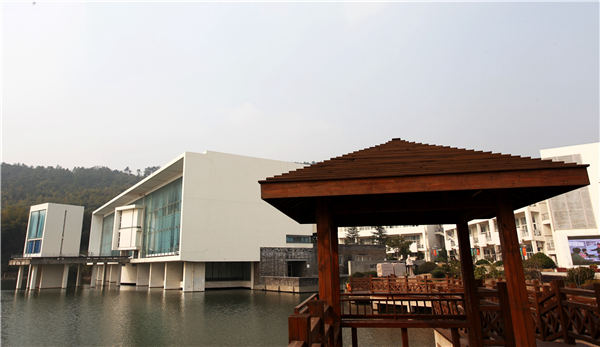
From the People's Daily app.
And this is Story in the Story.
In 1979, Thomas Jay Pritzker, chairman of the Hyatt Foundation, established what would later become one of the most distinguished awards for an architect to win, the Pritzker Prize.
Wang Shu, founder of the Hangzhou-based Amateur Architecture Studio, was awarded the coveted prize in 2012, marking the first time for a Chinese to receive the honor.
"It's very exciting to see young Chinese architects designing buildings, not just in China but around the world," said Pritzker, during a recent Beijing visit.
More Chinese architects are now being recognized on the international stage for their quality building designs.
Today’s Story in the Story looks at China’s emerging architects who have placed Chinese design and building innovation on the global stage for the first time ever.

The Xiangshan campus of the China Academy of Art in Hangzhou and a library in Suzhou University are among architect Wang Shu's representative works. (Photo: China Daily)
With a flair for integrated architecture, Wang Shu combines his eye for detail with a sense of place for every building he designs.
While growing up, he spent countless days riding trains from Beijing to Urumqi, in Northwestern China’s Xinjiang Uyghur Autonomous Region, where he used the time to observe and draw.
It was these early experiences, as Wang recalled, now 55 years old, that would later have an influence on his career.
The scenery during the long train rides would shift from urban to mountainous, and then change into forests and rivers, eventually dissolving into the Gobi Desert.
Wang said the experience broadened his mind and sparked his interest in local architecture, something he has cultivated ever since.
He would delineate every last detail on the train, all the way down to the smallest components. It was an exercise that would prove to be an essential building block leading to his success as an architect.
During an address at the 3rd Sino-French Cultural Forum in Xi'an, Shaanxi Province, Wang said the Silk Road is the embodiment of cultural diversity. Growing up in Urumqi, Xi'an, and Beijing, while living and studying in a range of buildings made of adobe, brick and other materials, he learned that architecture doesn't have to adhere to one particular cultural standard.
Although he has courted controversy through his work, often doubting the impracticability of his designs, Wang has always promoted the idea of integrating architectural design and the environment.
Through exploring new ways to combine the language of modern architecture with traditional Chinese concepts, Wang has helped create an innovative architectural style.
Wang brought his concepts to life when he designed the Xiangshan campus at the China Academy of Art in Hangzhou, Zhejiang Province. The project took five years to finish and used 7 million pieces of recycled bricks, tiles and stones, the end result was a culmination of 30 buildings all set in a natural landscape.
He would later apply similar concepts while designing two museums in Zhejiang Province, one in the port city of Ningbo, and the other in Fuyang.
Legendary French architect Paul Andreu, 80, designer of the Charles de Gaulle Airport in Paris, Pudong International Airport in Shanghai, and the National Center for the Performing Arts in Beijing, said he was impressed by the rural architectural designs from the new generation of Chinese architects whose work was exhibited at the Venice Biennale of Architecture, in Venice, Italy.
Even though they weren’t grand, they were far from mediocre, and represented a breath of fresh air within the world of Chinese architecture, Andreu said.
Andreu sees this rising generation emerging to the forefront, and through their efforts will continue to help China achieve significant change.
“Chinese architects are aware that inheriting tradition does not simply mean imitating ancient buildings, but rather drawing inspiration from the roots of their cultural connotations.,” he said.
As harmony and balance is the foundation of Chinese culture, Andreu says he hopes China will be able to bring more innovation and set an example for urban planning in the years to come.
Wang is currently working on a project in Yiyuan County, Shandong Province that aims to revitalize the rural area through art and design. The region is mostly populated by elderly folks as the younger generations have moved on to bigger cities.
Wang is also designing his first overseas project, a mixed community structure with rammed earth and timber that will be built in Paris, France.
Rammed earth is among the most sustainable of all building material. Through exchanges with French experts that first began 10 years ago, he has managed to find a modern solution for how to make the best use of the material.
"With such a huge amount of construction projects taking place in China, we should create pioneering examples for the world while on the path to sustainable development," Wang said.
(Produced by Nancy Yan Xu, Lance Crayon, Brian Lowe, Chelle Wenqian Zeng. Music by: bensound.com. Text from China Daily)


